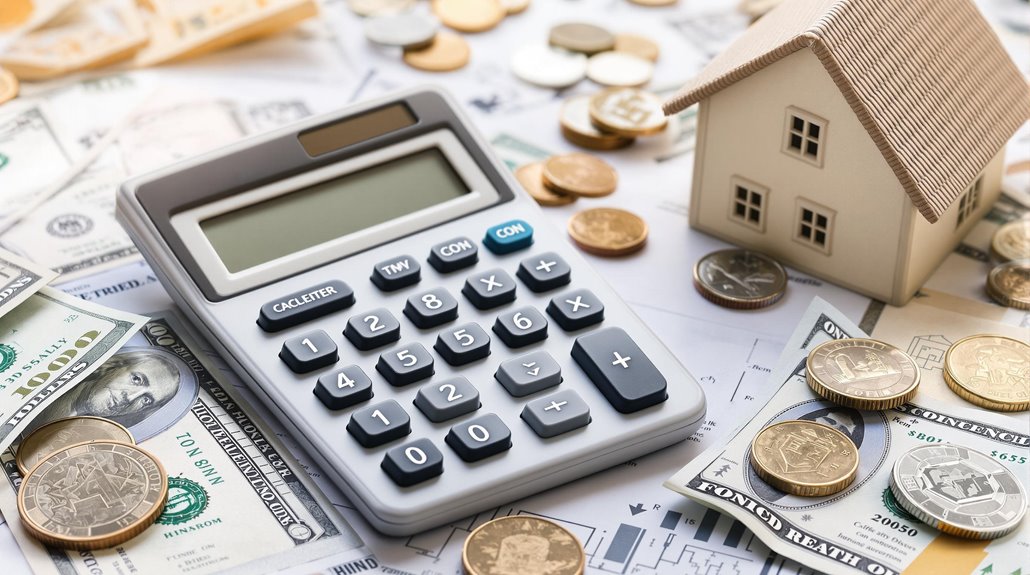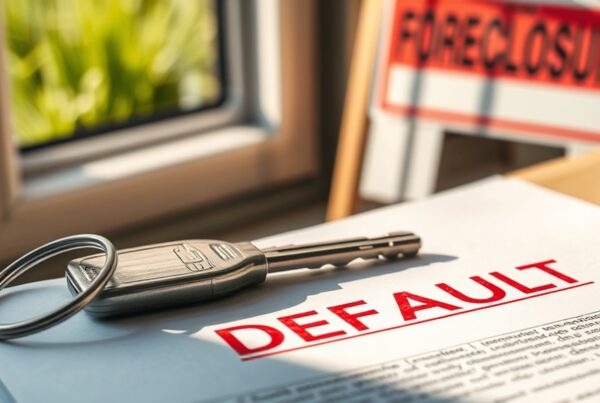To determine rental income, start by calculating your cash flow. Subtract all property expenses—like mortgage payments, maintenance, and management fees—from your gross rental income. A positive cash flow means your property earns more than it costs, which is key for long-term success. Use tools like Long Term Rental Calculators to assess ROI and spot financial gaps. Understanding how to Determine Rental Income helps you price competitively and maximize returns. Keep going to uncover more ways to optimize your investment.
Key Takeaways
- Calculate cash flow by subtracting all property expenses from total rental income to assess profitability.
- Use tools like Long Term Rental Calculators to evaluate ROI and rental income potential accurately.
- Gather and itemize expenses, including mortgage, utilities, maintenance, and management fees, for precise financial tracking.
- Analyze market rates, rental demand, and vacancy periods to project future earnings effectively.
- Adjust rental prices based on location, property condition, and local market trends to maximize income.
Importance of Positive Cash Flow
Positive cash flow is the cornerstone of rental property success, guaranteeing you’re earning more from rent than you’re spending on expenses. To achieve this, you need to determine how to figure rental income accurately by subtracting operating costs, mortgage payments, property taxes, insurance, and maintenance from monthly rent. Utilizing a Long Term Rental Calculator can simplify this process, providing precise insights into your financial projections. High rental income alone doesn’t guarantee profitability; meticulous expense tracking is crucial. Positive cash flow allows you to build reserves for emergencies, fund property upgrades, and sustain long-term investment viability. It directly impacts your return on investment (ROI), enhancing financial stability and growth. Conversely, negative cash flow strains your resources, making it necessary to monitor and optimize cash flow management. By focusing on how to figure rental income thoroughly and controlling expenses, you’ll guarantee your property remains a profitable asset, safeguarding your financial freedom.
How to Determine Rental Income
Cash flow represents the net income after subtracting expenses from rental revenue, acting as a key indicator of property profitability. When income exceeds expenses, you achieve positive cash flow, enabling reinvestment and financial stability. Conversely, negative cash flow occurs when costs surpass earnings, signaling potential financial strain and reduced investment returns. Utilizing tools like Long Term Rental Calculators can help assess rental profitability and ROI more effectively.
Cash Flow Basics
One fundamental measure of a property’s financial performance is its cash flow, which represents the difference between the total rental income and the associated expenses. To determine rental income accurately, you’ll need to include all sources, such as base rent, fees, and amenity charges. After calculating the gross rental income, deduct all property-related expenses, including mortgage payments, utilities, maintenance, and property management fees. The resulting figure indicates whether the property generates sufficient income to cover its costs. Monitoring cash flow helps you assess profitability and identify areas for financial improvement. A higher cash flow enhances ROI, guaranteeing long-term investment stability. Negative cash flow, however, signals that expenses exceed income, requiring strategic adjustments. Understanding these basics guarantees you make informed decisions when evaluating rental properties.
Positive Cash Flow
A property’s financial health is directly tied to its ability to generate more income than expenses, a state known as positive cash flow. To calculate property value based on rental income, you’ll first determine gross rental income, then subtract all associated costs, including mortgage payments, maintenance, and utilities. If the result is positive, you’ve achieved cash flow. For example, if your property generates $2,500 monthly and expenses total $2,000, you’re left with a $500 monthly profit. This surplus allows you to build financial reserves for emergencies or invest in property upgrades, increasing its long-term value. Regularly monitor this balance to guarantee your rental income consistently exceeds expenses. Achieving positive cash flow not only secures financial stability but also enhances your ability to reinvest or expand your property portfolio strategically. Understanding Key Performance Indicators also helps in measuring rent collection efficiency and property occupancy rates, further informing your investment decisions.
Negative Cash Flow
When a rental property doesn’t bring in enough income to cover its expenses, you’re dealing with negative cash flow. This occurs when operating costs, maintenance, vacancies, or mortgage payments exceed the rental income generated. To mitigate this, you should analyze the *property value based on rental income* to guarantee it aligns with market rates. Consider these steps:
- Evaluate expenses: Break down monthly costs like property taxes, insurance, and repairs.
- Adjust rental rates: Make sure rents are competitive but sufficient to cover expenses.
- Reduce vacancies: Implement strategies like marketing or tenant retention to minimize downtime.
Consistent negative cash flow can erode your financial stability, making it harder to maintain the property or invest elsewhere. Monitoring cash flow helps you make informed decisions to improve profitability and guarantee long-term sustainability. Understanding rental market analysis can provide deeper insights into optimizing rental income and maintaining a competitive edge.
Steps to Calculate Rental Income

You’ll first gather expense data, categorizing costs like property taxes, insurance, and maintenance to identify total outgoings. Then, project future earnings by analyzing rental demand, market rates, and vacancy periods to estimate gross income. Combine these figures to create a precise financial model for your property’s profitability. Google Analytics can be used to track and optimize your website’s booking funnel, providing insights to increase visitor engagement and conversions.
Gather Expense Data
To accurately assess rental income, start by compiling all property-related expenses, as these directly impact profitability. Determine rental property value by analyzing market comparables and appraisals, but also account for ongoing costs to guarantee accurate projections. Consider these key expense categories:
- Fixed Costs: Include mortgage payments, property taxes, and insurance premiums, as these remain consistent month-to-month.
- Variable Costs: Track utilities, repairs, and maintenance, which can fluctuate based on usage and property condition.
- Operational Costs: Factor in property management fees, legal fees, and marketing expenses for tenant acquisition.
Record every expense meticulously to avoid underestimating costs. If you’re analyzing cash flow, subtract these expenses from gross income, making certain you account for potential vacancies or unpaid rent. Cash-out refinance can be a strategic option to access equity for property improvements or additional investments. Precise expense tracking is essential to evaluate financial performance and determine the true profitability of your rental property.
Project Future Earnings
By analyzing gross income and subtracting all property-related expenses, you can project future earnings with precision. To understand how to compute rental income, start by determining the gross income from rent, fees, and amenities. Itemize all expenses, including mortgage payments, utilities, maintenance, and management fees, to assess cash flow accurately. Deduct these total expenses from the gross income to calculate net cash flow, which reflects the property’s financial performance. Multiply the monthly rental income by 12 to determine annual rental income, providing a clear picture of yearly earnings. Finally, use the rental income yield formula—divide the annual rental income by the total property cost and multiply by 100—to evaluate ROI. Understanding tenants’ preferences and market trends ensures that your property remains competitive and maximizes rental income. This systematic approach guarantees a detailed and reliable projection of your property’s future earnings.
Evaluating What Constitutes a Good ROI
When evaluating a good ROI for rental properties, a return between 4% and 10% is generally considered favorable, with returns above 10% often signifying strong investment potential. To assess ROI for a real estate investment, divide the net annual income by the total initial investment and express it as a percentage. Keep in mind that returns below 4% may not justify the investment compared to other opportunities. Here’s how to guarantee accurate ROI evaluation:
- Assess property value—Analyze the purchase price, renovation costs, and other expenses to determine your total investment.
- Compare local averages—Evaluate your predicted ROI against market-specific benchmarks to gauge competitiveness.
- Factor in ongoing costs—Include maintenance, tenant turnover, and other variables that impact net income.
- Diversify your holdings—To enhance financial stability, consider investing in Real Estate Investment Trusts (REITs) alongside rental properties.
Thorough financial analysis guarantees you maximize returns on your real estate investment property value, making market-specific data and precise calculations essential.
Alternative Methods for Calculating Rental Income

Since traditional methods might not always provide a thorough view, alternative techniques offer additional ways to calculate rental income with greater accuracy. Utilizing a rental property calculator allows you to input data like purchase price, maintenance costs, and vacancy rates to generate a detailed breakdown of potential income and expenses. The one percent rule, a quick metric, suggests your gross monthly rental income should be at least 1% of the property’s total value to guarantee positive cash flow. Conducting a comparative market analysis (CMA) compares your property to similar ones in the area, refining your understanding of fair rental rates. Estimate annual income by subtracting total expenses from projected rental income, giving you a clearer picture of profitability. Online property agencies also provide tools showing median sales prices and average rental rates, helping you determine how to value rental property effectively.
Key Factors Influencing Rental Value
Determining rental value hinges on several essential factors that directly impact a property’s income potential, with location being the most influential. When asking, “how much is my rental property worth?”, you’ll need to analyze these key elements:
- Location: Properties in high-demand neighborhoods with access to amenities, transportation, and services command higher rents. For example, a unit in a bustling urban area typically yields more than one in a remote location.
- Property Features: Size, layout, and condition notably influence rental value. Larger units or those with extra bedrooms, bathrooms, or modern renovations can attract premium rates.
- Market Dynamics: Supply and demand play a vital role. In a landlord’s market, where rental inventory is scarce, you can charge more, while a tenant’s market may require competitive pricing.
Strategies for Maximizing Rental Income

To maximize rental income, start by setting a competitive price point based on comparable properties in your area, guaranteeing it aligns with market demand while remaining attractive to tenants. Use the one percent rule to guide your rental property valuation, aiming for a gross monthly income of at least 1% of the property’s purchase price. Enhance the property’s appeal by investing in upgrades like modern appliances or fresh paint, which can justify higher rental rates. Offering amenities such as in-unit laundry or dedicated parking spaces can further increase your income potential. Regularly review local market trends and adjust rents accordingly to sustain growth. Below is a table summarizing key strategies:
| Strategy | Action | Impact |
|---|---|---|
| Competitive Pricing | Research local market rents | Attracts quality tenants |
| One Percent Rule | Set rent at 1% of purchase price | Guarantees cash flow sustainability |
| Property Upgrades | Modern appliances, fresh paint | Justifies higher rental rates |
| Amenity Additions | In-unit laundry, parking spaces | Increases income potential |
Conclusion
You’ve learned that calculating precise rental income involves understanding cash flow, expenses, and potential ROI. By analyzing property taxes, maintenance costs, and market trends, you can determine if a rental is profitable. Research shows that properties with a 6-8% ROI often yield sustainable returns. Always confirm assumptions with real data to avoid overestimating income. Rigorous analysis guarantees you’re not just chasing theoretical gains but building a reliable investment portfolio.




